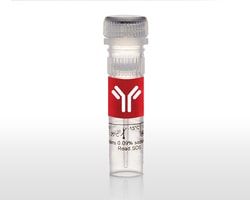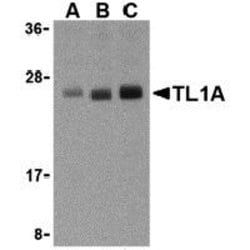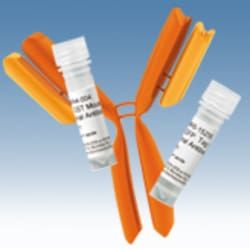CD178 Monoclonal Antibody (101624), Invitrogen™
Manufacturer: Thermo Scientific
Select a Size
| Pack Size | SKU | Availability | Price |
|---|---|---|---|
| Each of 1 | MA124729-Each-of-1 | In Stock | ₹ 50,507.50 |
MA124729 - Each of 1
In Stock
Quantity
1
Base Price: ₹ 50,507.50
GST (18%): ₹ 9,091.35
Total Price: ₹ 59,598.85
Antigen
CD178
Classification
Monoclonal
Concentration
0.5 mg/mL
Formulation
PBS with no preservative
Gene Accession No.
P41047
Gene Symbols
Fasl
Immunogen
Purified, recombinant mouse Fas ligand (residues 132-279).
Quantity
100 μg
Primary or Secondary
Primary
Target Species
Mouse, Porcine
Product Type
Antibody
Isotype
IgG1
Applications
ELISA, Inhibition Assays, Neutralization, Western Blot
Clone
101624
Conjugate
Unconjugated
Gene
Fasl
Gene Alias
ADAM10-processed FasL form; ALPS1B; APL; Apoptosis (APO 1) antigen ligand 1; apoptosis (APO-1) antigen ligand 1; Apoptosis (APO-1) antigen ligand 1 (Fas antigen ligand); apoptosis antigen ligand; APT1LG1; APTL; CD178; CD178 antigen; CD95 ligand; CD95 ligand protein;Generalized lymphoproliferative disease (Gld); Cd95l; CD95-L; CD95L protein; fas antigen ligand; Fas ligand; Fas ligand (TNF superfamily, member 6); Fasl; Fas-L; FasL ICD; FasL intracellular domain; Faslg; Fas-LG; generalized lymphoproliferative disease; gld; mutant tumor necrosis factor family member 6; Receptor-binding FasL ectodomain; sFasL; Soluble Fas ligand; soluble form; SPA; SPPL2A-processed FasL form; TNFL; Tnfsf6; TNLG1A; Tumor necrosis factor (ligand) superfamily member 6; Tumor necrosis factor (ligand) superfamily member 6 (apoptosis (APO-1) antigen ligand 1) (Fas antigen ligand); Tumor necrosis factor (ligand) superfamily, member 6 (apoptosis (APO-1) antigen ligand 1) (Fas antigen ligand); Tumor necrosis factor ligand; tumor necrosis factor ligand 1A; tumor necrosis factor ligand superfamily member 6; Tumor necrosis factor ligand superfamily member 6 (TNFL6 / TNFSF6); Tumor necrosis factor ligand superfamily member 6, membrane form; Tumor necrosis factor ligand superfamily member 6, soluble form
Host Species
Rat
Purification Method
Protein G
Regulatory Status
RUO
Gene ID (Entrez)
14103
Content And Storage
Store at 4°C short term. For long term storage, store at -20°C, avoiding freeze/thaw cycles.
Form
Liquid
Description
- MA1-24729 is expected to cross react with human (100% conserved), feline (89% conserved), and porcine (88% conserved) due to sequence homology
- The Neutralization Dose50 (ND50) for Monoclonal Anti-Mouse Fas Ligand is approximately 10-20 μg/mL
- Store product as a concentrated solution
- Centrifuge briefly prior to opening the vial
- CD178 (Fas ligand, FasL) is a type-II-membrane protein, whose N-terminus is in the cytoplasm and its C-terminal region extends into the extracellular space
- Its receptor, FasR, is a cell-surface-type-I-membrane protein and a member of the tumor necrosis factor (TNF) and nerve growth factor (NGF) receptor family
- As a member of the TNF-cytokine family CD178 induces apoptosis when interacting with FasR
- CD178 may exist as either membrane bound (45 kD) or soluble forms (26 kD)
- The soluble protein can be released from cells upon cleavage by metalloproteinases
- Binding of CD178 to Fas leads to oligomerization of the receptor and triggers apoptotic cell death through the interaction of other proteins
- CD178 is predominantly expressed in activated T-lymphocytes and natural killer (NK) cells also it is expressed in the tissues of immune-privilege sites such as testis and eye
- CD178 expression is also reported in various tissues as thymus, liver, ovary, lung, heart and kidney
- It is assumed that induction of apoptosis through CD178 is predominantly involved in anti-viral immune responses
- CD178 is a cell surface molecule belonging to the tumor necrosis factor family, binds to its receptor Fas, thus inducing apoptosis
- Various cells express FAS, where CD178 is expressed predominantly on activated T cells
- FAS and CD178 are involved in the down-regulation of immune reactions as well as T cell-mediated cytotoxicity
- CD178 concentration has also been shown to be associated with atherosclerosis and inflammatory disease, in patients with hypertension
- The Fas/ CD178 system has been shown to play a role in a number of human diseases, for example AIDS, hepatitis or cancer.




